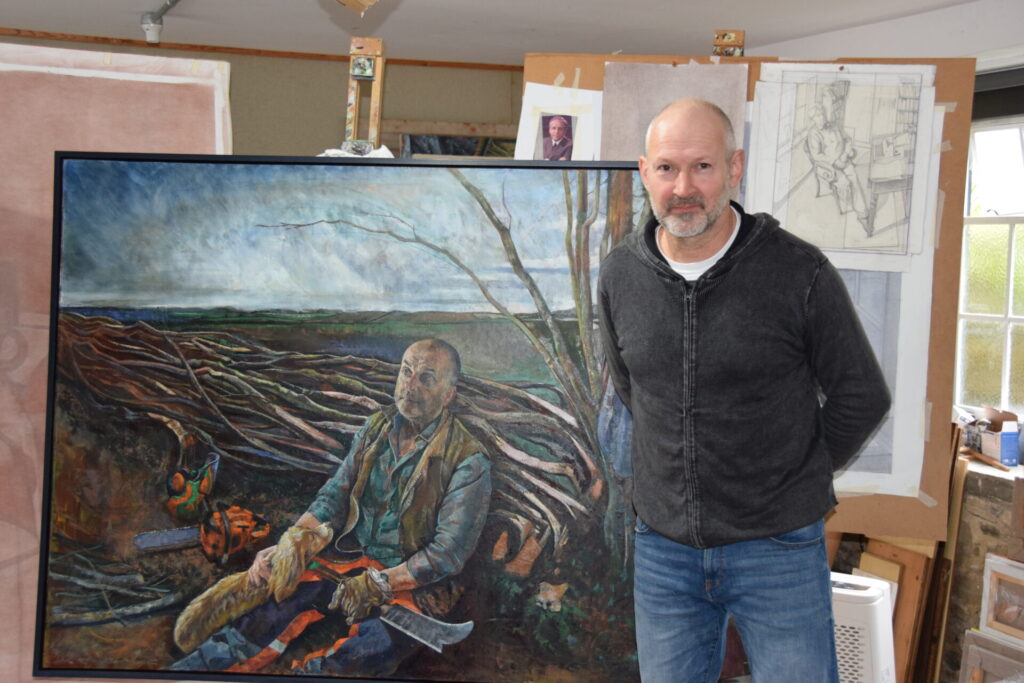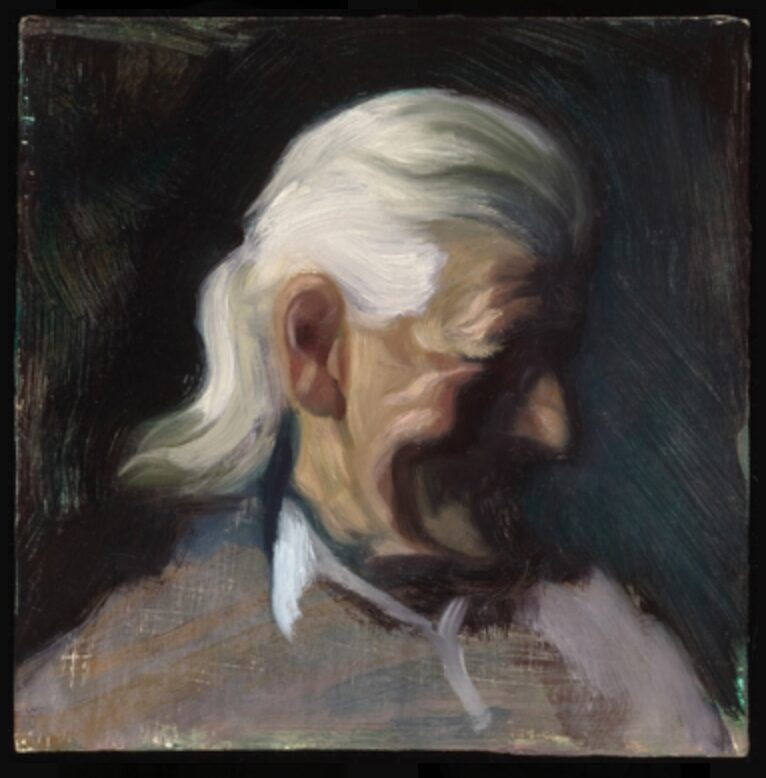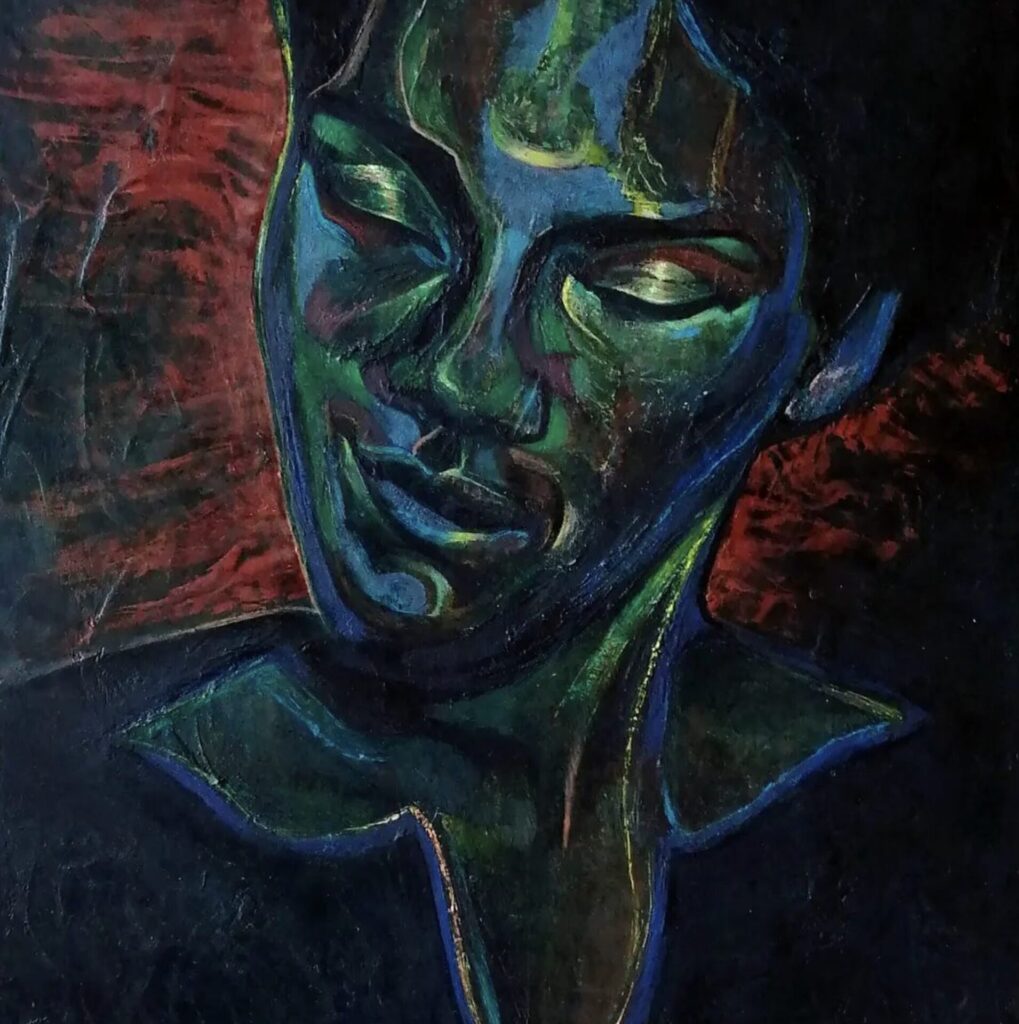The award-winning artist is continuing a century-old tradition at Dunshay Manor, the Purbeck home of the sculptor Mary Spencer-Watson
Dorset painter Toby Wiggins was born just a few miles from the home and studio of the late sculptor, Mary Spencer Watson. The ancient landscape, with its quarries and Saxon farmsteads, eventually drew him back to Purbeck where he now has his studio in one of Spencer Watson’s old buildings.
His earliest memories were formed by traditional farmwork, the sounds of the stonemasons, the wildlife, the cries of seabirds and an unusual relationship between the local landowner and the tenants.
Toby won the prestigious 2023 Ondaatje Prize for Portraiture for a powerful and deeply moving study of a local master hedge-layer, Russell Woodham. When you visit Toby’s studio on Purbeck, the portrait dominates the large space. It draws you in. You are instantly attracted to the warmth, intelligence and wry humour on Russell’s face, to his obvious love for his cocker spaniel, Conker, who stands close to him, to the timeless beauty of a traditionally laid Dorset hedge.
Elsewhere in the studio there are sketches and studies, a full-length portrait of Mary Spencer Watson (right), whose studio was once here, and a rather sombre study of a man in a suit, with a mountain behind him. This is a commissioned portrait for a board-room, and it is as different from the paintings of Russell and Mary as it is possible to imagine from the same artist’s brushes.
These three paintings, set in the studio in old farm buildings at Dunshay Manor, between Harman’s Cross and Langton Matravers, give even the most casual visitor an insight into both the portrait painter’s skill and the nature or character of the sitter.
The businessman gives nothing away, but his upright posture, with a snow-covered mountain in the background, suggests power and perhaps a rather uncompromising attitude. There are no objects or clues to hint at his interior life.
Mary Spencer Watson (1913-2006) is also uncompromising – this was a woman whose sculpture was inspired by the geology around her family home at Dunshay, and by watching the masons cutting Purbeck stone in quarries where she would select stone for her carvings.
Mary’s sculptures include the Four Evangelists, who stand outside the Chapter House at Wells Cathedral.
Mary was born in London but in 1923 her family – her father was the artist George Spencer Watson and her mother, Hilda, was a dancer and mime artist – moved to the late 16th century Dunshay Manor. This was her home for the rest of her life. The family decorated the Manor in the Arts and Crafts style and used its outbuildings as studios and for dance and theatre productions.
In Toby’s portrait, Mary looks strong and deeply intelligent. You can imagine from the physical solidity of her pose, the uncluttered background and her monochrome clothes that she was as “hefted” to Purbeck as the Herdwick sheep are to their native Lake District.
Russell Woodham is similarly at one with the setting, resting for a few minutes beside the hazel hedge he is laying in the Dorset style, on an unidentified hillside in West Dorset. It is winter, because that is when you lay hedges. It is hard, physical work, and Russell has been doing it for decades (see the profile on Russell in The BV, Oct 21 here).

Finding his art
Toby grew up in a tiny tenanted cottage on Afflington Farm, one of several ancient farmsteads around Dunshay. As a child, he saw hedge-laying and quarrying, and observed the unusual way that Mary Spencer-Watson managed her tenants – they were not charged rent, but instead did whatever jobs were needed around the property. He showed an early aptitude for painting and drawing, which was encouraged by teachers at school and at Bournemouth College of Art. Toby went on to study at Falmouth College, followed by three years postgraduate study at the Royal Academy Schools. He worked in London for some years, but was pulled back to Dorset in the early 2000s.
He has always kept in mind advice that Mary was given by her father: ‘It’s a privilege to do this [make art]. Take it seriously. Work hard.’
Toby is self-deprecating – he says there are many people who have more natural talent than him, but are perhaps not prepared to put in the long hours of work, false starts and failed attempts that go with completing a satisfactory portrait. He worked hard at art college and received a rigorous training at the Royal Academy Schools, where the skills of drawing, sculpture and the various disciplines of painting were all taught.
From the promise of Toby’s early artistic endeavours, Mary Spencer Watson had taken an interest in the talented youngster. Back in Dorset as a professional artist, Toby asked if he could paint her portrait, and in 2004, after the work was finished, she allowed him to use her studio: ‘She wanted someone to continue artistic practice at Dunshay. And of course I did some jobs for her!’
Following her death in 2006, there was a lengthy legal battle over the future of Dunshay, but eventually the Landmark Trust (to which Mary had bequeathed the house) gained ownership and began the lengthy project of repairing and restoring the ancient manor ready for Landmark guests. At this point, Toby moved into a second studio, where he continues to work. The Trust opened Dunshay Manor for groups to stay in 2019.

Seeing things differently
In 2006, Toby won the BP Travel Award, a competition run in conjunction with the National Portrait Gallery, which is aimed at encouraging artists to focus on and develop the theme of portraiture in their work. As someone who had done occasional farm work ‘to pay the rent,’ Toby’s proposal was to travel around Wessex and paint people working on farms and in the landscape.
‘I was interested in the farmed landscape,’ he says. ‘When you have worked on a farm you see things differently. I wanted to include people who made their living from traditional crafts such as blacksmithing, thatching, hedge-laying, coppicing, hurdle making, charcoal burning and hunting. I wanted to discover what was left of a working countryside that Thomas Hardy might recognise. I found it – a trace of it.’
The range of people he painted for the project is wide and fascinating – from the near-legendary Dionis McNair, one of the few women Verderers of the New Forest, to hurdle-maker Alan Brown of Wool and shepherd Larry Skeats, who effectively saved the ancient shepherds’ huts (now a mainstay of rural glamping), and for years was the much-loved landlord of The Trooper Inn at Stourton Candle.
The BP Travel Award series was shown at the National Portrait Gallery in London and, with some additional studies, including a Purbeck quarryman, at Dorset County Museum in 2008.

In the Dorset style
‘But I didn’t get a hedgelayer,’ says Toby. Later, he noticed a sign saying “Dorset Hedgelayer” in a newly-laid hedge near Dunshay.
‘I messaged him on Instagram, and Russell said to come on over and meet him.’
They met on a sunken track leading to a derelict farmstead near Rampisham. The hazel hedge was ‘quite overstood’ – tall, leggy and losing the density of scrub at the base, affecting its value for wildlife as well as its ability to provide a good stock- proof barrier. Russell was laying it in the Dorset style.
The process of painting his portrait was a lengthy one, spread over more than a year, says Toby. He made drawings and sketches, and in the summer Russell came to the studio to sit for him.
It was important that the painting should include Conker, Russell’s constant companion.
There are so many details to discover in the finished portrait – the more you look into it, the more you find. There is the age-old skill of the hedgelayer in the way the hazel is cut and bent to reshape the old hedge, there is the jacket hanging from a hazel spar like a coat-hook – ‘It’s quite a nice office,’ says Russell – and the tools, from the traditional billhook to the necessary 21st century chainsaw. The eye is drawn in different directions by the arcs of hazel branches, the shape of the hazel woven into the hedge, the swing of the axe, the rounded lines of the helmet and visor, and the relaxed position of the hedgelayer, leaning back against a half-finished section.
Most of all, you come back to Russell’s face – weather-beaten, serious, intelligent, with a quizzical lift of the eyebrow and just the faintest hint of a smile. It is a man enjoying a brief rest from hard physical work that is utterly timeless.

The portrait, which is called Winter’s Work; Russell Woodham at rest while laying a hazel hedge in the Dorset Style. The painting has gone to the National Portrait Gallery for the second round of judging for the Herbert Smith Freehills Portrait Award.

Artistic conversations
Toby was elected a member of the Royal Society of Portrait Painters in 2006. He won the Prince of Wales Drawing Award in 2005 and 2013, the Changing Faces Prize in 2006 and the Lynn Painter-Stainers Prize for figurative painting in 2009.
He has exhibited widely, including at the Royal Academy of Arts, Royal West of England Academy in Bristol, the National Portrait Gallery, the Holburne Museum in Bath and the Jerwood Space. For more than ten years he taught at Arts University Bournemouth, but now fully focuses on his work as a painter – though he still teaches occasional local classes. Primarily a portraitist, he also draws and paints landscapes and still lifes.
His next exhibition is with fellow portrait painters Anthony Connolly, who has his studio at Semley, and Kent-based Andrew James. Their work will be shown at the Highgate Gallery in London from 12th to 25th April. The Heart Has Its Reasons: Three painters in Conversation brings the artists together ‘in the spirit of artistic conversations which lead to the works and connections that emerge via three distinctive visual languages,’ says Toby.


Three Painters In Conversation from 12th to 25th April at Highgate Literary and Scientific Institute
While his portrait of Russell may finally live in London, the painting of Mary Spencer Watson will move just a few yards to its new permanent home. Originally bought by the revered Dorset Museum curator Roger Peers, who died in 2023, it was bought at the posthumous auction of Peers’ art works by the Landmark Trust and will soon be on display in Dunshay Manor.
‘We ought to have it here, for Mary’s sake,’ says Anna Keay, the architectural historian and director of the Landmark Trust.


